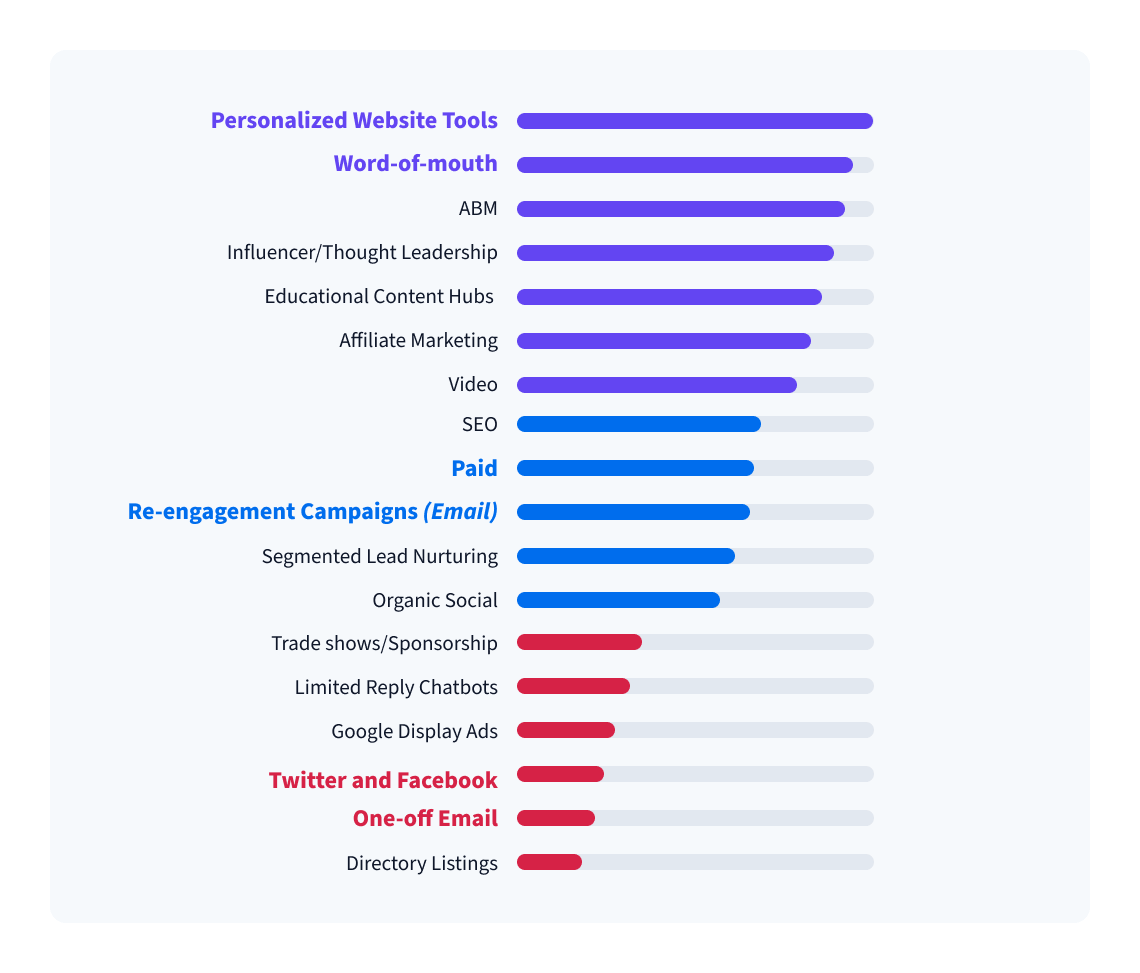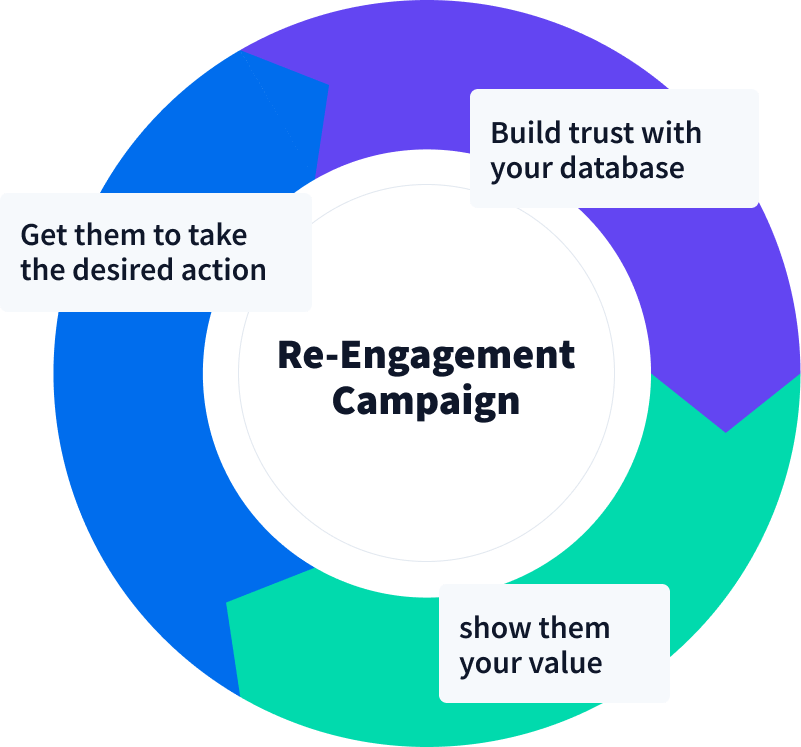SmartAcre Debates: What Marketing Channels Should You Invest In, Maintain, and Retire?
Once per quarter, our SmartAcres debate a timely marketing topic. In Q3, we took on marketing channels where a lively discussion broke out over what channels we would invest in, maintain, and retire. To make sure everyone was aligned, we defined Invest, Maintain, and Retire as:
- Invest – The buzzy, “hot right now” thing in marketing
- Maintain – The tactic you want to keep indefinitely
- Retire – The tactic that is dead to us
After everyone presented their arguments and a healthy conversation was had, the SmartAcre team came to the agreement that we’d invest in Personalized Website Tools and Word-of-Mouth, maintain Paid Advertising and Re-engagement Campaigns via Email, and we’d retire Twitter and Facebook as well as One-off Emails.
Why these channels? Read on for our arguments.
Marketing Channels – Invest | Maintain | Retire
Invest
Personalized Website Tools
Personalization is everywhere now, and there is no reason why it can’t be used on your website, especially as more and more tools are developed that can be integrated into it. Knowing your audience and using the data and tools you have can deliver a specific experience that improves the user experience.
According to Adobe, 68% of B2B businesses use collected data to drive personalization across their website and 58% report the personalization tactic that works best is personalized site search results.
When you know your audience, you can give them exactly what they need and want. How, you may ask? Utilize smart content. By targeting specific content to visitors, you can strengthen your website and provide a better user experience.
Word-of-Mouth
We all agreed that we aren’t 100% sure how you invest in word-of-mouth and expand it, but we know we should because word-of-mouth works.
Almost 91% of all B2B sales are influenced by word-of-mouth. Almost everything, every purchase, happens today because of word-of-mouth.
When you can get someone to vouch for you and/or the product, it goes a lot further in helping the decision-making process than the company telling someone why they should trust them and buy. So, if your company isn’t doing so, reach out to current and former customers asking them to leave you a review on
- your social channels
- your website
- other trusted review sites like Trustpilot
Also, create case studies or client stories highlighting successful projects you’ve done and the results. Be sure to ask for a quote from the client that speaks to their experience. This way, when people visit your site, they can see how you impacted a customer instead of just seeing your product or service offerings.
Maintain
Paid Advertising
While paid advertising has experienced changes lately, we believe it still has a place in marketing as a tactic. We still Google things and click on ads (even if accidentally), and ads can still work. But only if the ads are strategic and continuously monitored and updated. You can’t just “set it and forget it.” You need to ensure your keyword research is thought out and correct. Remember, if you aren’t buying your keywords, someone else is. You don’t want to burn money on the wrong keywords or lose potential customers to a competitor because you had the incorrect research. When thinking about your paid ad strategy and keywords, stop and consider what people are already searching for. Then, use those terms for whatever you’re promoting because you know there’s search volume, and the ad will get seen. One place where we think paid can work is on social for ABM-type marketing. You can tailor your ads and target groups and get your company into communities where people are active. That way, you know you’ll be seen and increase your ROI.
Re-engagement Campaigns (Email)
Email was a hot topic during the debate, with many agreeing one-off emails are old news (read on for that argument) but that re-engagement campaigns utilizing emails should be maintained as a tactic. With re-engagement campaigns, you’re reaching people who showed an interest in you. While they may be a cold lead now, they know who you are and what you offer and may just need a few touchpoints to remember why they initially engaged with you and re-engage. With a re-engagement campaign, you can build trust with your database, show them your value, and ultimately get them to take the desired action.
Re-engaging a lead is easier and more cost-effective than trying to generate new ones or grow your database. A re-engagement campaign also helps you keep your database clean and your email metrics desirable. At the end of the campaign, you can remove those contacts who bounced or didn’t re-engage. This helps you know that you’re sending emails to only those who want to hear from you and are more likely to take action on the email.
Retire
Twitter and Facebook
From a B2B perspective, we don’t think Facebook and Twitter (yes, we’re still calling it Twitter) work as a channel. The platforms are too noisy and organic posts don’t see great engagement, as there’s too much traffic. The News Feed tends to be 1 post that the person wants to see (like a personal update from a follower) and then just ads, so people either leave the platform or scroll for the sake of scrolling but don’t stop to consume the content.
We’ve also seen a downward trend in advertising on these platforms. Ad engagement has been less and less, the leads that come in aren’t usually qualified, and the ROI isn’t there to make it worth it.
One-off Emails
So while we said we’d maintain re-engagement emails, we think it’s time to retire one-off emails. Similar to Twitter and Facebook, there is so much noise that our inboxes are always flooded. While people still read emails, we aren’t reading every single one that comes in. Emails only get read when they grab our attention, but often that catchy subject line is “click-bait.” Once we’re in the email, we don’t find it relevant and realize we don’t need it. It then looks bad on the company for “tricking” us into opening it.
We also tend to ignore emails from someone we don’t know, so a one-off email will either get ignored, trashed, and/or end up in spam. 14.3% of all emails go missing or get caught by spam filters, wasting the hard work and strategy you put into creating the email.
Plus you have to consider the impact that data privacy changes are having on email. Unlike in a re-engagement campaign where you can build trust with your audience, with one-off emails, there’s not a relationship, there’s no trust with your audience, so they aren’t going to click on your emails.
Additionally, we’ve found that a lot of times, the information that we get from an email can be found elsewhere, like on social. We don’t need or want to get the information multiple times, we’re already oversaturated.
For the last few years, the case has been made that email isn’t dead and there is a place for it but we think the time has come to sunset the majority of emails.
Our debate brought up a lot of good points for all tactics and channels, and while we’ve highlighted just a few here, it doesn’t mean that we’re going to focus only on those four that we said to invest in or maintain. However, we will continue to explore and evaluate channels as part of our marketing strategies. If you’re interested in seeing how SmartAcre can make these marketing channels work for you as part of your B2B marketing strategy, let’s set up a time to talk.



